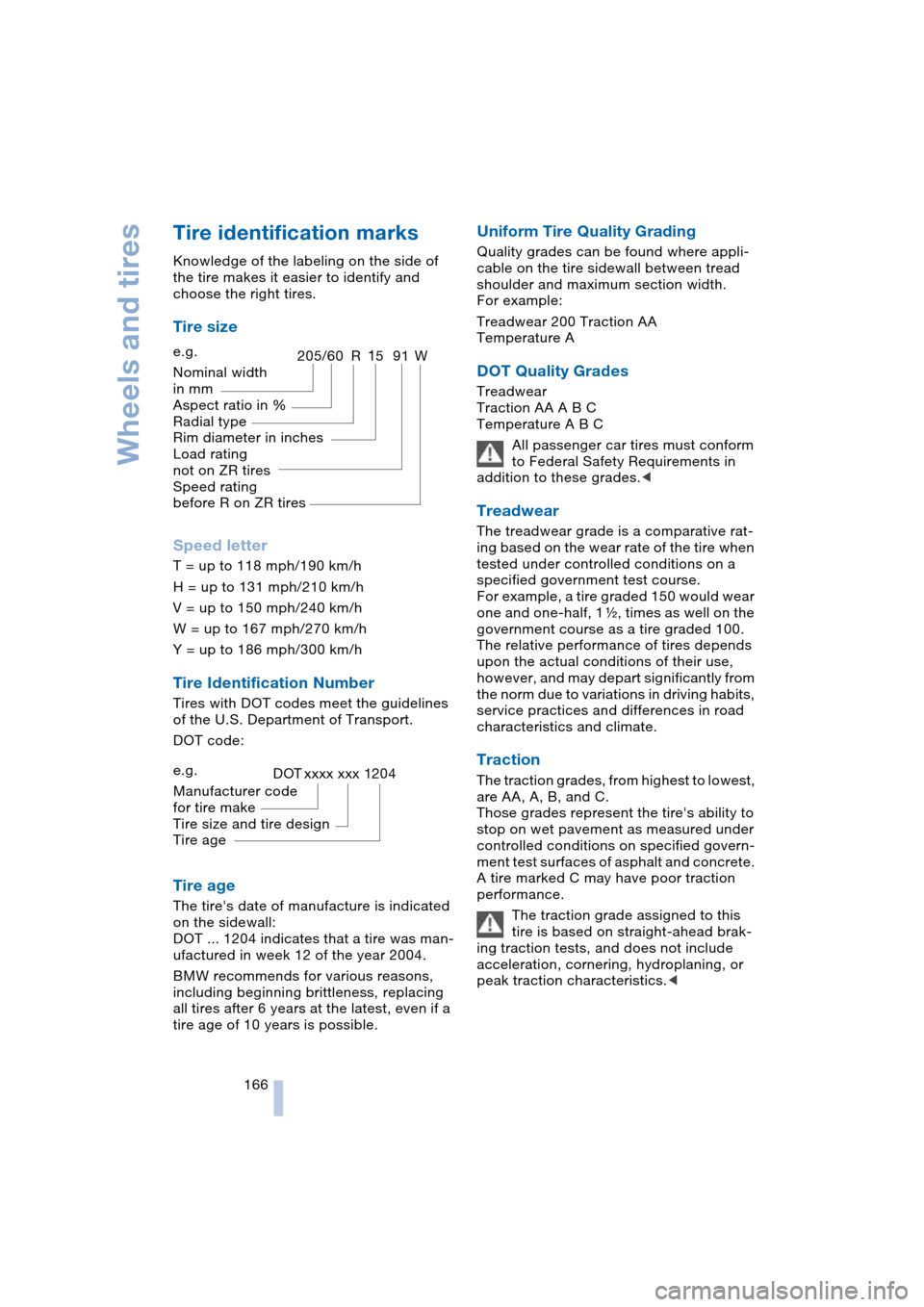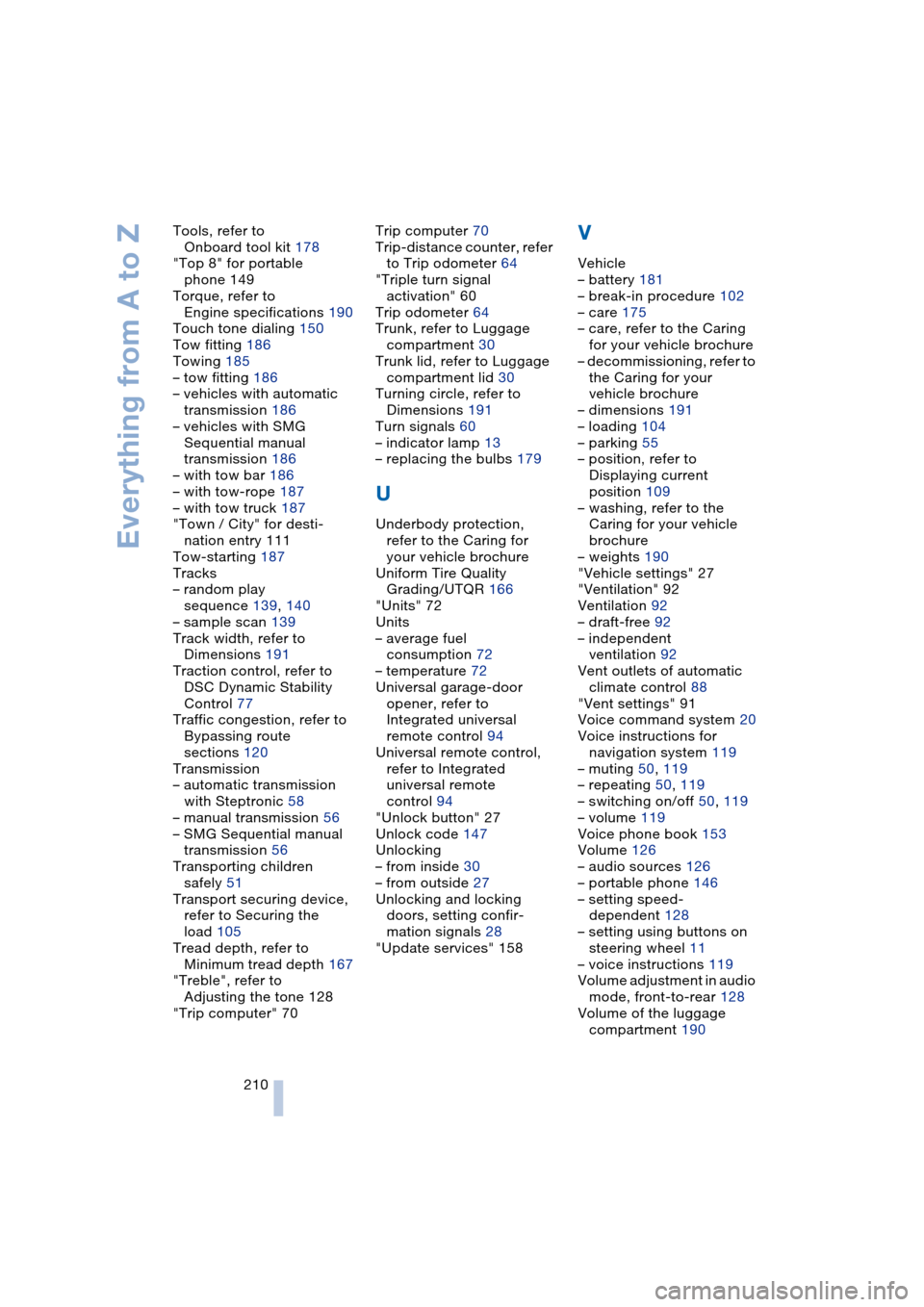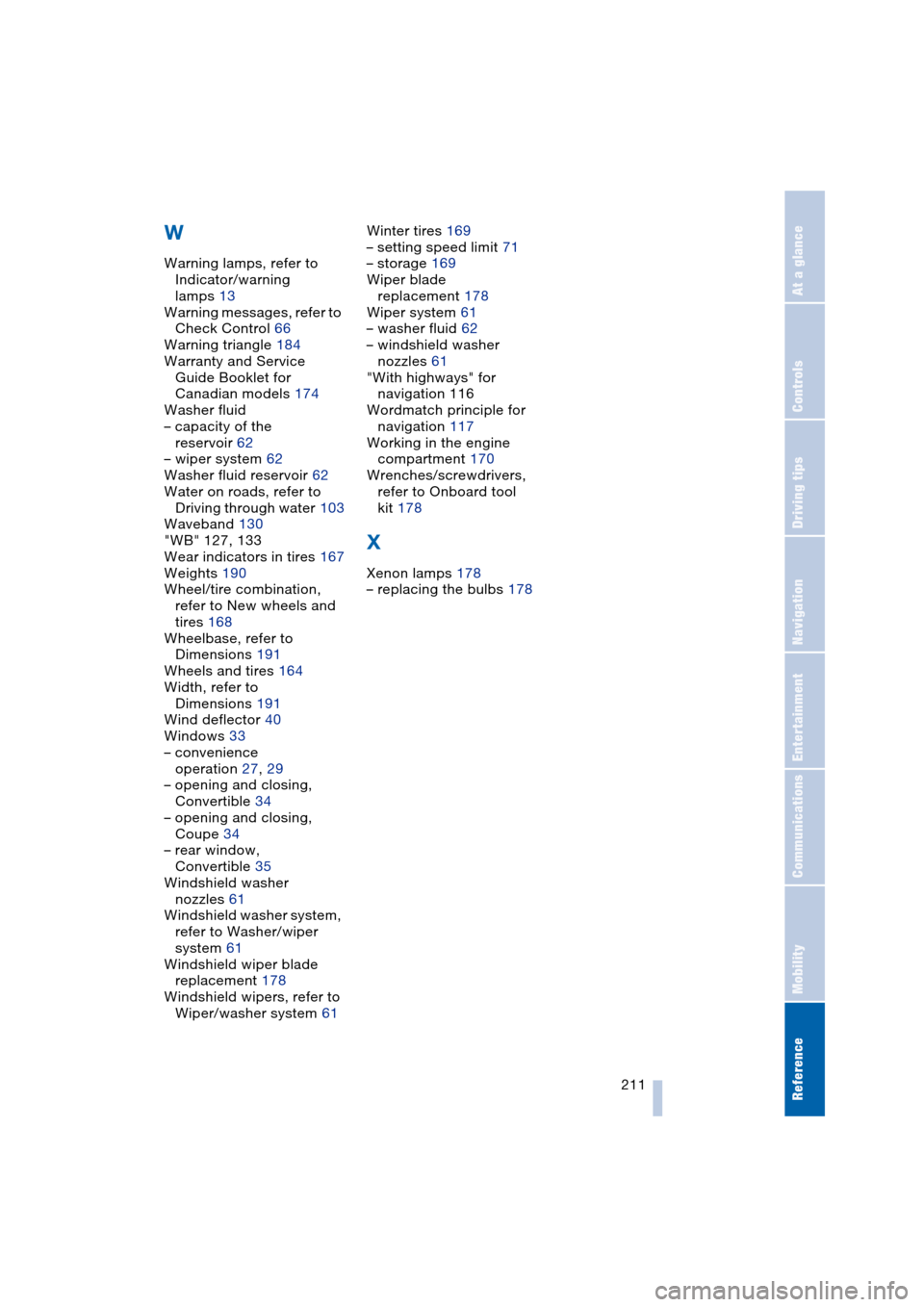2004 BMW 645CI COUPE width
[x] Cancel search: widthPage 50 of 216

Adjustments
48
Mirrors
Adjusting exterior mirrors
Armrest in the driver's door:
14-way adjustment
2Switching to the other mirror or auto-
matic curb monitor, refer to page 45
To prevent the exterior mirrors from
being damaged due to the width of
the vehicle, always fold them in by hand
before entering an automatic car wash.<
You can also adjust the mirrors manually
if necessary by pressing against the outer
edges of their lenses.
Storing the mirror positions, refer to Seat,
mirror and steering wheel memory,
page 44.
The mirror on the passenger's side
features a lens with a more convex
surface than the mirror installed on the
driver's side. When estimating the distance
between yourself and other traffic, bear in
mind that the objects reflected in the mirror
are closer than they appear. This means
that estimations of the distance to following
traffic should not be regarded as precise.<
Automatic functions
>Both exterior mirrors are automatically
heated in ignition key position 2
>The interior and exterior mirrors dim
depending on the light occurring when
the vehicle is being driven forward
*.There are two photocells in the interior
mirror to control the automatic dimming
of the interior mirror. One is integrated
within the mirror's lens, refer to arrow,
while the other is located at an offset
position on the rear of the mirror hous-
ing.
For trouble-free operation, keep the
photocells clean and do not cover the
area between the interior rearview mir-
ror and the windshield. Do not attach
any kind of stickers on the windshield in
front of the mirror, either.
Steering wheel adjustment
Do not adjust the steering wheel while
the vehicle is moving. There is a risk
of accident from unexpected movement.<
The steering wheel can be adjusted in four
directions.
Storing the steering-wheel position, refer
to Seat, mirror and steering wheel memory,
page 44.
Page 104 of 216

Things to remember when driving
102
Things to remember when driving
Break-in procedures
To ensure that your vehicle continues to
provide optimized economy of operation
throughout an extended service life, we
request that you devote careful attention to
the following section.
Engine and differential
Up to 1,200 miles/2,000 km:
You should attempt to vary both vehicle
and engine speeds. Until the break-in
period has been completed, you should
also refrain from exceeding an engine
speed of 4500 rpm or a driving speed of
100 mph/160 km/h.
Always obey all official speed limits.
Avoid full-throttle operation and use of the
transmission's kickdown mode during
these initial miles.
Once you have driven 1,200 miles/
2,000 km, the engine and vehicle speeds
can be gradually increased.
SMG Sequential manual
transmission
Do not use the acceleration assistant dur-
ing the break-in period, refer to page 60.
Tires
Due to technical factors associated with
their manufacture, tires do not achieve their
full traction potential until after an initial
break-in period. Therefore, drive reservedly
during the first 200 miles/300 km.
Brake system
Brakes require an initial break-in period of
approx. 300 miles/500 km to achieve opti-
mized contact and wear patterns between
brake pads and rotors.
Clutch
The function of the clutch is only at its opti-
mized level after a distance driven of
approx. 300 miles/500 km. During this
break-in period, engage the clutch gently.
After component replacement
You should also comply with these break-in
procedures should the components men-
tioned above need to be replaced at a later
point.
General driving notes
Hot exhaust system
Extreme temperatures occur at the
catalytic converter on this and every
catalyst-equipped vehicle. Do not remove
the heat shields installed adjacent to vari-
ous sections of the exhaust system, and
never apply undercoating to them. When
driving, standing at idle and while parking,
take care to avoid possible contact
between the hot exhaust system and any
highly flammable materials such as hay,
leaves, grass, etc. Such contact could lead
to a fire, and with it the risk of serious prop-
erty damage as well as personal injury.<
Parking vehicle
Condensation forms in the air conditioner
system during operation, and then exits
under the vehicle. Traces of condensed
water under the vehicle are thus normal.
Before driving into a car wash
Fold in the exterior mirrors manually, as
otherwise they could be damaged due to
the width of the vehicle.
Hydroplaning
When driving on wet or slushy roads,
reduce road speed. If you do not, a
wedge of water can form between tires and
Page 168 of 216

Wheels and tires
166
Tire identification marks
Knowledge of the labeling on the side of
the tire makes it easier to identify and
choose the right tires.
Tire size
Speed letter
T = up to 118 mph/190 km/h
H = up to 131 mph/210 km/h
V = up to 150 mph/240 km/h
W = up to 167 mph/270 km/h
Y = up to 186 mph/300 km/h
Tire Identification Number
Tires with DOT codes meet the guidelines
of the U.S. Department of Transport.
DOT code:
Tire age
The tire's date of manufacture is indicated
on the sidewall:
DOT ... 1204 indicates that a tire was man-
ufactured in week 12 of the year 2004.
BMW recommends for various reasons,
including beginning brittleness, replacing
all tires after 6 years at the latest, even if a
tire age of 10 years is possible.
Uniform Tire Quality Grading
Quality grades can be found where appli-
cable on the tire sidewall between tread
shoulder and maximum section width.
For example:
Treadwear 200 Traction AA
Temperature A
DOT Quality Grades
Treadwear
Traction AA A B C
Temperature A B C
All passenger car tires must conform
to Federal Safety Requirements in
addition to these grades.<
Treadwear
The treadwear grade is a comparative rat-
ing based on the wear rate of the tire when
tested under controlled conditions on a
specified government test course.
For example, a tire graded 150 would wear
one and one-half, 1g, times as well on the
government course as a tire graded 100.
The relative performance of tires depends
upon the actual conditions of their use,
however, and may depart significantly from
the norm due to variations in driving habits,
service practices and differences in road
characteristics and climate.
Traction
The traction grades, from highest to lowest,
are AA, A, B, and C.
Those grades represent the tire's ability to
stop on wet pavement as measured under
controlled conditions on specified govern-
ment test surfaces of asphalt and concrete.
A tire marked C may have poor traction
performance.
The traction grade assigned to this
tire is based on straight-ahead brak-
ing traction tests, and does not include
acceleration, cornering, hydroplaning, or
peak traction characteristics.< e.g.
Nominal width
in mm
Aspect ratio in X
Radial type
Rim diameter in inches
Load rating
not on ZR tires
Speed rating
before R on ZR tires
205/60 R1591W
e.g.
Manufacturer code
for tire make
Tire size and tire design
Tire ageDOT xxxx xxx 1204
Page 212 of 216

Everything from A to Z
210 Tools, refer to
Onboard tool kit 178
"Top 8" for portable
phone 149
Torque, refer to
Engine specifications 190
Touch tone dialing 150
Tow fitting 186
Towing 185
– tow fitting 186
– vehicles with automatic
transmission 186
– vehicles with SMG
Sequential manual
transmission 186
– with tow bar 186
– with tow-rope 187
– with tow truck 187
"Town / City" for desti-
nation entry 111
Tow-starting 187
Tracks
– random play
sequence 139, 140
– sample scan 139
Track width, refer to
Dimensions 191
Traction control, refer to
DSC Dynamic Stability
Control 77
Traffic congestion, refer to
Bypassing route
sections 120
Transmission
– automatic transmission
with Steptronic 58
– manual transmission 56
– SMG Sequential manual
transmission 56
Transporting children
safely 51
Transport securing device,
refer to Securing the
load 105
Tread depth, refer to
Minimum tread depth 167
"Treble", refer to
Adjusting the tone 128
"Trip computer" 70Trip computer 70
Trip-distance counter, refer
to Trip odometer 64
"Triple turn signal
activation" 60
Trip odometer 64
Trunk, refer to Luggage
compartment 30
Trunk lid, refer to Luggage
compartment lid 30
Turning circle, refer to
Dimensions 191
Turn signals 60
– indicator lamp 13
– replacing the bulbs 179
U
Underbody protection,
refer to the Caring for
your vehicle brochure
Uniform Tire Quality
Grading/UTQR 166
"Units" 72
Units
– average fuel
consumption 72
– temperature 72
Universal garage-door
opener, refer to
Integrated universal
remote control 94
Universal remote control,
refer to Integrated
universal remote
control 94
"Unlock button" 27
Unlock code 147
Unlocking
– from inside 30
– from outside 27
Unlocking and locking
doors, setting confir-
mation signals 28
"Update services" 158
V
Vehicle
– battery 181
– break-in procedure 102
– care 175
– care, refer to the Caring
for your vehicle brochure
– decommissioning, refer to
the Caring for your
vehicle brochure
– dimensions 191
– loading 104
– parking 55
– position, refer to
Displaying current
position 109
– washing, refer to the
Caring for your vehicle
brochure
– weights 190
"Vehicle settings" 27
"Ventilation" 92
Ventilation 92
– draft-free 92
– independent
ventilation 92
Vent outlets of automatic
climate control 88
"Vent settings" 91
Voice command system 20
Voice instructions for
navigation system 119
– muting 50, 119
– repeating 50, 119
– switching on/off 50, 119
– volume 119
Voice phone book 153
Volume 126
– audio sources 126
– portable phone 146
– setting speed-
dependent 128
– setting using buttons on
steering wheel 11
– voice instructions 119
Volume adjustment in audio
mode, front-to-rear 128
Volume of the luggage
compartment 190
Page 213 of 216

Reference 211
At a glance
Controls
Driving tips
Communications
Navigation
Entertainment
Mobility
W
Warning lamps, refer to
Indicator/warning
lamps 13
Warning messages, refer to
Check Control 66
Warning triangle 184
Warranty and Service
Guide Booklet for
Canadian models 174
Washer fluid
– capacity of the
reservoir 62
– wiper system 62
Washer fluid reservoir 62
Water on roads, refer to
Driving through water 103
Waveband 130
"WB" 127, 133
Wear indicators in tires 167
Weights 190
Wheel/tire combination,
refer to New wheels and
tires 168
Wheelbase, refer to
Dimensions 191
Wheels and tires 164
Width, refer to
Dimensions 191
Wind deflector 40
Windows 33
– convenience
operation 27, 29
– opening and closing,
Convertible 34
– opening and closing,
Coupe 34
– rear window,
Convertible 35
Windshield washer
nozzles 61
Windshield washer system,
refer to Washer/wiper
system 61
Windshield wiper blade
replacement 178
Windshield wipers, refer to
Wiper/washer system 61Winter tires 169
– setting speed limit 71
– storage 169
Wiper blade
replacement 178
Wiper system 61
– washer fluid 62
– windshield washer
nozzles 61
"With highways" for
navigation 116
Wordmatch principle for
navigation 117
Working in the engine
compartment 170
Wrenches/screwdrivers,
refer to Onboard tool
kit 178
X
Xenon lamps 178
– replacing the bulbs 178